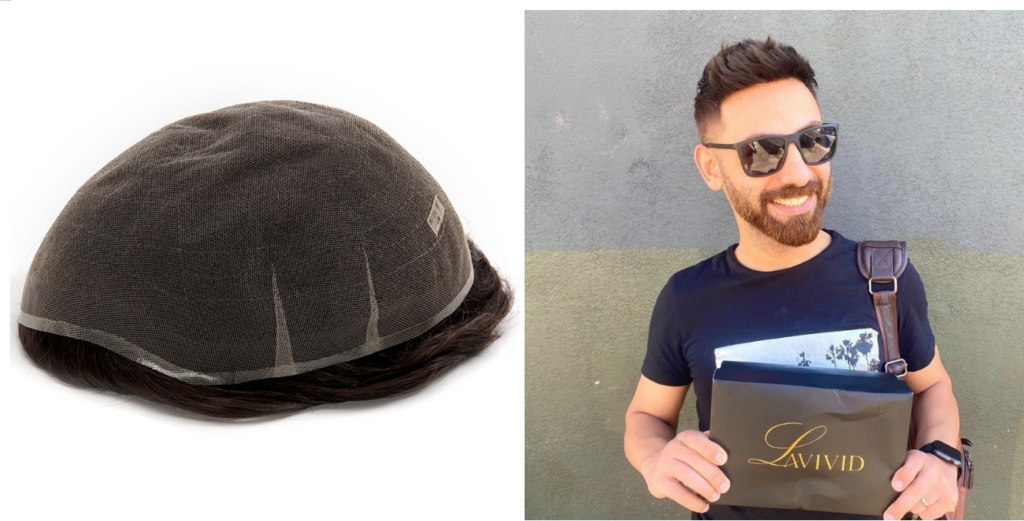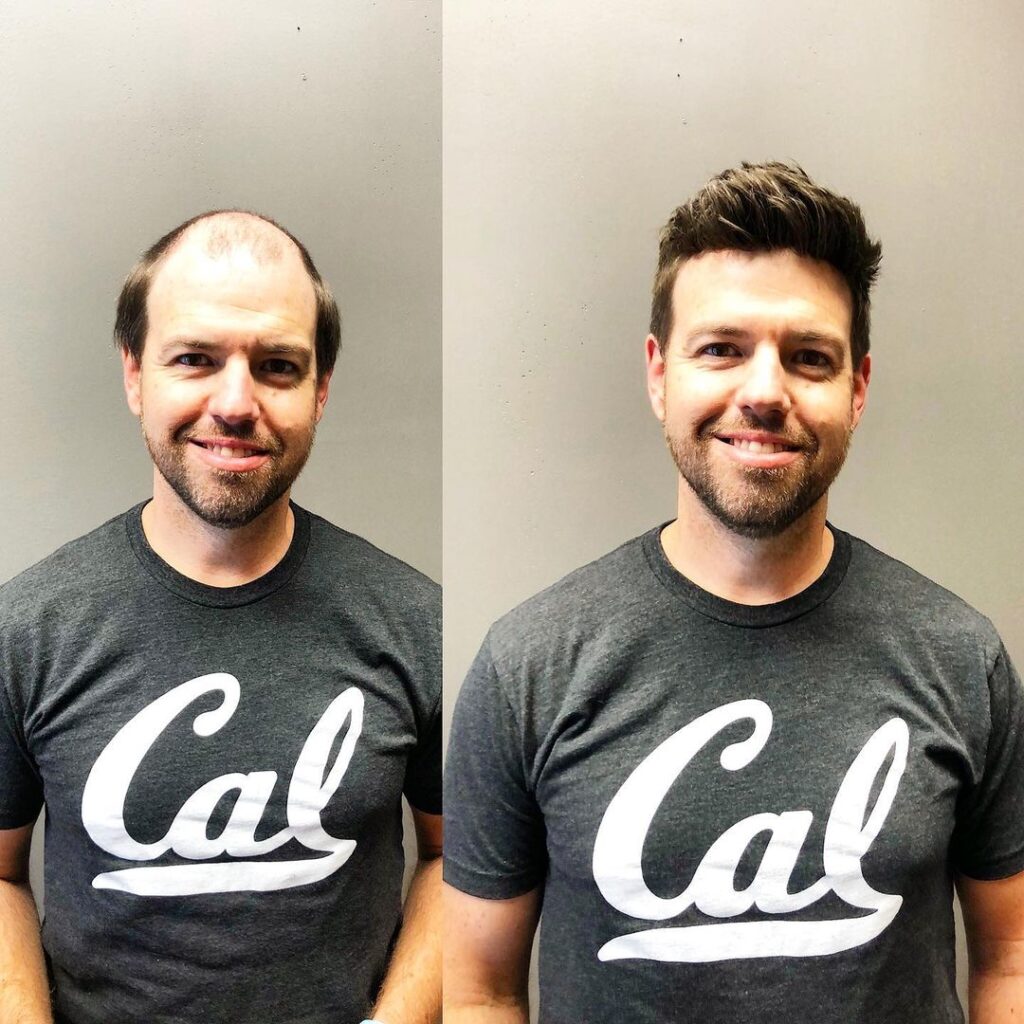Hair systems provide solutions for hair loss, but they’re only as good as their base materials. The base creates the structure that hair strands are knotted into. It must be comfortable, secure, and undetectable. The two main base materials for hair pieces are lace and polyurethane. What are the differences between these bases and how do you choose? Let’s compare lace and polyurethane to understand the features and suitability of each.

What is Lace?
Lace refers to several fine mesh netting materials used to construct hair system bases. French lace, Swiss lace, and poly lace are common varieties. Lace creates sheer, breathable, and flexible bases. Hair knots are either hand-tied or machine-wefted into the lace fabric.
Some benefits of lace bases:
- Light and Airy
The open weave structure makes lace bases lightweight. Their porosity also allows air flow to the scalp preventing sweat and heat buildup. The lightness of the base itself allows the wearer to barely feel it on their head.
- Comfortable to Wear
Lace bases conform to the shape of the head for a custom fit. Their flexibility and minimal thickness reduces tension on the scalp. There are no rigid edges that could dig into the skin. The customizable fit and stretchy texture contribute to a level of comfort that makes the hair system easy to wear all day.
- Realistic Appearance
The grid-like lace foundation blends into the scalp and gives a natural looking emergence of the hair, especially important at the hairline. The tiny knots don’t obstruct the scalp and look like hair naturally growing from pores. Even up close, the hair seems to organically sprout from the scalp rather than being weaved into a base.
- Easy to Style and Maintain
The flexibility of lace makes it easy to style the attached hair in any direction. Hair can be brushed back or forward with no resistance from the base. Maintenance tasks like cleaning and re-applying adhesives are also simple due to the adaptable nature of lace. It can be lifted, stretched, and maneuvered to access the entire scalp.
- Longer Lasting
High quality lace made with premium materials can last 12-24 months with proper care and maintenance before needing replacement. Hand-tied knots strengthen the attachment of hair strands to withstand styling and cleaning. Swiss and French laces are more durable than basic poly lace.
- Natural Movement
Along with flexibility for styling, lace allows the attached hair to move fluidly in a natural way. The strands can shift and bounce with your motions. Stiff bases impede natural hair actions. The dynamic nature of quality lace mimics your bio hair’s mobile qualities.
- Transparent Appearance
Whatever the skin tone or scalp color, lace can be colored and blended to match. Transparent lace virtually disappears onto the skin. It provides invisibility at the hairline and part lines. This disguises where the hair system ends and your scalp begins.
- Customizable Density
The hand knotting technique can create precise patterns and alter the density as needed. Densely packed knots fill in bald spots. Wider spaced knots match thinning areas. The knotting can graduate from dense to sparse to mimic natural changes.
What is Polyurethane?
Polyurethane (poly) refers to thin, synthetic polymer materials used for hair system bases. The term monofilament is also used to describe a type of fine polyurethane base. They provide a smooth foundation for attaching hair.
Here are some noteworthy benefits of polyurethane bases:
- Lightweight Feel
Like lace, poly bases are lightweight enough that the wearer barely feels them on the head. Their non-porous structure also blocks sweat absorption. You won’t feel bogged down by a heavy, sweaty base on hot days.
- Strong and Durable
The synthetic fibers of polyurethane make it very strong. This allows the bases to maintain their shape and integrity over long periods of time. The sturdy composition resists tearing from styling brushes, friction, and cleaning. It remains structurally sound despite regular handling.
- Invisible Edges
Quality poly bases have fine, “invisible” edges that effortlessly blend into the skin for an undetectable transition line. The tapering mimics the hairline’s natural diffusion into the skin. Well-crafted edges are essential for the most discreet systems.
- Natural Movement
Monofilament polys allow the hair to shift and part naturally just like real scalp hair. This adds to the realism of the system. Synthetic bases sometimes have an artificial stiffness. Monofilament mimics how natural hair falls and reacts to motion.
- Affordable Cost
Poly bases tend to be more affordable than natural lace. Those on budget constraints can still get a decent material. While inexpensive, lower grade poly looks more artificial. High quality options appear very life-like for the moderate price.
- Quick Drying
The non-absorbent quality of poly also makes drying fast after washing. It doesn’t retain water that can breed bacteria. The base dries straight from the wash to expedite the cleaning routine.
- Stain Resistant
Polyurethane repels stains from hair products, oils, and adhesives better than other materials. Liquids sit on top rather than absorbing into the fibers. This allows for stain-free wear between cleanings.
- Non-Irritating Texture
The smooth, seamless texture of quality poly feels gentle on the skin. Hair sprouts from tiny perforated holes. There are no knots, seams, or edges that could rub and cause irritation. It is comfortable for all-day wear.
- Easy Maintenance
Keeping polyurethane clean is simple. It can be quickly sprayed down and wiped. The durable composition isn’t prone to tearing or drying out from cleaning. Shampooing and conditioning the hair causes minimal wear.
Now that you understand the benefits of each material, how do you know whether to choose lace or polyurethane?
Factors for Comparing Lace and Poly
When deciding between lace and polyurethane, keep these factors in mind:
- Hair Loss Extent – If you need to cover an expansive bald area, polyurethane works better as it’s more durable and affordable. Lace works for spot baldness because its delicacy suits smaller areas. The stamina of poly withstands larger systems.
- Budget – Good quality Swiss or French lace systems can cost $1000+ just for the base materials and construction. Polyurethane starts under $200 for the base itself. Labor charges add to the total either way. The cost difference can be substantial.
- Hairline Type – The fine hand-tied knotting of lace mimics the intricate randomness of a natural hairline better. But monofilament polyurethane looks convincingly natural for straight, solid hairlines. The knotted lace recreates nuanced recession patterns.
- Hair Type – Coarse, tightly curled styles hold up better against matting and friction with a polyurethane base. Fine limp hair or straight locks move and flow more freely with a lace base. Curls resist the traction of lace. Straight hair shows lace lines.
- Base Colors – Polyurethane only comes in a limited range of solid color choices. These may not always match the wearer’s scalp color well. Various lace colors and effects like transparent offer more blending options for any skin tone.
- Hairline Customization – Lace construction allows for any intricate hairline shape the client desires. The hand knotting personalizes the hairline. Polyurethane has set hairline edges and patterns that can’t be adjusted much beyond some trimming.
- Maintenance – Lace requires gentler maintenance products and careful handling to not damage the delicate knots and fabric. Tough polyurethane stands up well to regular cleaning, conditioning, blow drying, and adhesion with minimal deterioration.
- Durability – Polyurethane withstands more chemical processing like perms, colors, bleaches, and heat styling. Lace is damaged by harsh chemicals compromising longevity. But gentle treated hair survives well on lace.
- Ease of Sizing – Getting polyurethane models in multiple sizes is straightforward – small, medium, large based on head dimensions. Lace sizing relies on custom measuring and molding for precision. Off-the-shelf poly is simpler to size up.
Lace vs. Poly by Hair Loss Type
To further understand which material may suit your specific kind of hair loss scenario:
Lace Recommended For:
- Widows Peak Hairlines – Lace knotting can accurately recreate irregular peaks and jagged recession patterns. The random knots form natural looking points.
- Temple Recession – The hand-tied knots taper gracefully to mimic progressive temple recession. The thinning effect looks authentic.
- Diffuse Thinning – Sheer lace fabrics and dispersed knots disguise diffuse thinning without leaving bald gaps. It hides wispy, decreasing density.
- Shorter Styles – Lace moves and conforms better to accommodate the demands of shorter haircuts. Long styles conceal lace seams.
- Spot Covering – Small patches of hair loss blend right into the surrounding bio hair with lace bases. The seamless integration looks natural.
Polyurethane Recommended For:
- Full Crown Coverage – Polyurethane covers large bald crown spots affordably. Lace would require multiple pieces driving up costs.
- Straight Hairline – Monofilament polyurethane convincingly imitates the straight, solid fringe of a maturing hairline. The uniform density looks natural.
- Curly Hair – Dense, kinky curls withstand the rigors of daily wear and maintenance better against hardy polyurethane. Fragile lace risks tearing.
- Buzzed Styles – Tough poly won’t rip out strands or develop holes when buzzing down the sides and back with clippers. Lace risks getting shredded.
- Advanced Hair Loss – The reliable sturdiness of poly is ideal for advanced stages of loss needing full coverage across the whole scalp.
- Active Lifestyles – Poly stands up to sweat, oils, frequent washing and athletics better. Delicate lace requires gentler care.
Blends Offer the Best of Both Worlds
Rather than choosing strictly lace or polyurethane, many hair systems combine both materials into one superior blended base. Here are two popular hybrid options:
Lace Frontals
Lace frontals feature hand-tied lace knotting along the front hairline and perimeter. This extends back 2-4 inches before blending into a monofilament or polyurethane rear section that covers the majority of the scalp. The lace lace frontal creates the illusion of natural hair growth along the hairline. This seamlessly integrates into the durable polyurethane rear for a secure overall foundation. It provides a discreet front and maximum coverage in the back.

Poly Perimeter with Lace Top
These bases use thin polyurethane material around the perimeter edges. This hugs the sides and nape area for optimal blending with the skin and a sturdy hold. The top uses a sheer lace material like French lace to allow breathability through the center and natural movement. This design provides the best of both materials where they are needed most. The poly edges ensure security while the lace top enhances ventilation and mobility.
Blended hair system bases provide advantages of both lace and polyurethane strategically placed where they are most beneficial. For many hair loss sufferers, a blend offers an ideal combination of comfort, security, and natural aesthetics in one multi-functional base.
Finding the Right Material for You
When exploring hair replacement systems, there are many factors to weigh when deciding on a base material. Consider your budget, expectations, kind of hair loss, and lifestyle needs. Identify any non-negotiables. Try being open to considering a blended base material that mixes the desirable qualities of different fabrics. Book consultations with specialists where you can see and try various hair systems. Ask questions to understand how different bases are constructed. Seeing and handling the materials firsthand makes the choice more informed. Let an experienced professional examine your scalp and suggest suitable options. Investing in a base that performs well and looks natural for years to come is worth finding the right match. While sifting through the many choices seems daunting initially, the perfect solution will click when you find it.
Lace vs. Poly: Understanding Hair System Base Materials
Toupees provide solutions for hair loss, but they’re only as good as their base materials. The base creates the structure that hair strands are knotted into. It must be comfortable, secure, and undetectable. The two main base materials for hair systems are lace and polyurethane.